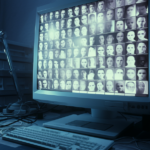Researchers led by Michal Kosinski at Stanford University have published a study in the journal American Psychologist demonstrating that facial recognition technology can predict a person’s political orientation from neutral facial expressions with a statistically significant accuracy.

The study used a facial recognition algorithm – VGGFace2 in a ResNet-50-256D architecture – to analyze standardized photographs of 591 participants, controlling for variables such as makeup, jewelry, and facial expressions, to focus purely on facial features. These features were encoded into numerical vectors and analyzed to predict political leanings.
The facial recognition system performed with a correlation coefficient of .22—a modest but statistically significant result. This coefficient ranges from -1 to +1, where 0 implies no correlation, and 1 or -1 implies a perfect positive or negative correlation, respectively.
While the result is, to some extent, remarkable, a second step in the experiment also produced a notable result. The researchers recruited 1,026 human raters through Amazon’s Mechanical Turk service and asked them to assess the political orientation of the subjects in the standardized facial images. They completed over 5,000 assessments, and their predictions were about as good as those of the facial recognition system, delivering a correlation coefficient of .21.
“I was surprised that both algorithms and humans could predict political orientation also from carefully standardized images of expressionless faces,” Kosinski said in comments to PsyPost. “That suggests the existence of links between stable facial features and political orientation.”
While certain demographics tend toward particular political leanings – for example, men tend to be more conservative than women – the researchers took extensive measures to ensure that their study controlled for demographic factors that could influence the predictions of political orientation based on facial features. They did this by decorrelating participants’ scores on a political orientation scale from their age, gender, and ethnicity. This methodological step was crucial to isolate the effect of facial features alone on political orientation predictions.
In practice, this meant that the predictive model they developed, and the subsequent analysis were refined to ensure that any correlations found were not merely reflecting demographic characteristics that are traditionally associated with certain political orientations. Instead, the focus was on whether distinct facial features could independently predict political orientation.
The study’s conclusions offer interesting implications, perhaps most notably the idea that political beliefs can somehow be encoded in an individual’s face to some degree. But given the relative weakness of the correlation, it’s probably best not to make any assumptions that could spark a heated debate in an election year.
Sources: PsyPost, APA PsycNet
–
April 17, 2024 – by Alex Perala







Follow Us